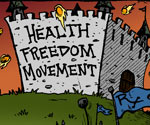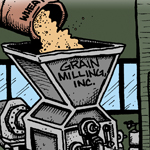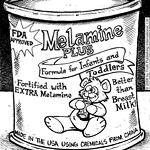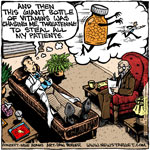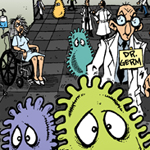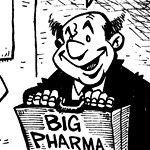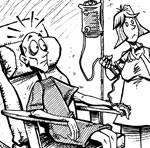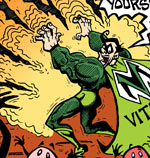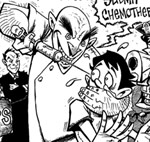Rutin Benefits - Rutin for Hemorrhoids, Blood Vessels and Other Health Conditions
| Share on Facebook | Share on Twitter | Share on Google+ |
What is rutin? Rutin is a complex sugar found in abundance in buckwheat, and also in lesser amounts in asparagus, rhubarb, and the peels and rinds of citrus fruit. The name rutin comes from Ruta graveolens, the scientific name of the herb common rue, which also contains rutin. Before 1950, rutin was called "vitamin P," although it is not actually a vitamin.
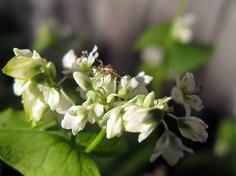
Rutin can combine with heavy metals, binding them, and preventing them from causing toxic effects. In the human body, rutin can remove excess iron and copper. However, it can also prevent calcium, iron, and mangesium from being absorbed from food, so rutin should not be taken with mineral supplements or with meals.
Health Benefits of Rutin
There are a number of beneficial effects of rutin in the human body. Here are just a few:
- Rutin counteracts platelet-activating factor (PAF), which causes blood clot formation and which triggers the inflammatory reactions of allergies.
- Rutin counteracts aldose reductase, an enzyme that transforms glucose sugar into a sugar alcohol called sorbitol. Sorbitol can thicken the lenses of the eyes and the linings of the nerves, causing damage to sight and sensation.
- Rutin can reduce the rate at which oxidized LDL cholesterol attracts the white blood cells that transform it into the plaque that hardens arteries.
- Rutin is a mild anti-inflammatory agent and a strong antioxidant. And, most importantly,
- Rutin strengthens the linings of blood vessels throughout the body, reducing bleeding and preventing collapse.
Rutin for Blood Vessels
The greatest benefits of rutin are in treating unsightly varicose veins in the legs and treating swollen varicose veins around the anus known as hemorrhoids.
A derivative of rutin known as hydroxyethylrutoside (or more precisely a trihydroxyethylrutoside) treats a condition known as chronic venous insufficiency, in which the valves in the veins in the legs cannot pump enough oxygen-poor blood back to the heart.
Chronic venous insufficiency can cause night-and-day itching of the legs, patches of dark brown pigmentation, and varicose eczema, with a high risk of infection.
Rutin and rutin derivatives also treat hemorrhoids and varicose veins during pregnancy, phlebitis caused by birth control pills, and spider veins on the face, thighs, or ankles.
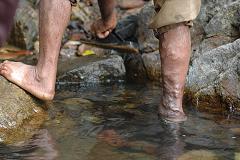
Photo by Jackerhack
Hesperidin and Rutin
Rutin is usually formulated with another plant flavonoid called hesperidin in nutritional supplements. Rutin is technically a "citrus bioflavonoid," but not all products labeled as "citrus bioflavonoids" actually contain rutin. Hydroxyethylrutosides are a separate product that may be formulated with yet another plant chemical called aescin, which is derived from horse chestnut seeds.
Rutin Dosing
Once you have made sure that the supplement you are using actually contains rutin, take at least 500 mg of rutin per day. You may have to read the label to find out how much rutin is in each capsule. As noted below, much higher dosages of rutin may be helpful:
- From 500 up to 4,000 mg of hydroxyethylrutosides per day may be helpful for hemorrhoids. The more severe the hemorrhoids, the higher the suggested dosage.
- 1,000 mg of the hydroxytehtylrutoside product Venotron daily is typically used to treat varicose veins or venous insufficiency.
- A rutin derivative called troxerutin is often used to treat spider veins and varicose veins during pregnancy. Up to 4,000 mg a day (in four divided doses) for up to 4 months may be helpful.
- Up to 3,000 mg of hydroxyrutosides every day may counteract phlebitis caused by birth control pills, but consult your physician. Don't try to treat phlebitis on your own.
- Venous insufficiency is usually treated by 500 mg of hydroxyethylrutosides three times a day.
Rutin Side Effects
There are no rutin side effects, but any antioxidant can interfere with the action of chemotherapy or radiation for cancer. If you choose to undergo these treatments for cancer, avoid interfering with their effects by staying off all antioxidant supplements during the weeks you take radiation or chemo.
Antioxidants may help you recover from the side effects of cancer treatment more quickly once you complete a treatment, but you should not take rutin or any other antioxidant while you are taking cancer treatment.
It may cost more to buy a single supplement that contains both rutin and vitamin C, so it may be more economical to buy one rutin or citrus bioflavonoid supplement and a separate vitamin C supplement.
Drug Interactions
Hydroxyelthylrutoside and troxerutin supplements occasionally have side effects. The most common problem is a skin rash. In elderly users, there may also be stomach upset, constipation, dry mouth, or diarrhea. These problems are only likely to occur unless the user also takes multiple blood pressure medications including one or more diuretics.
Hydroxyethylrutoside and troxerutin supplements may also interact with certain medications.
- When rutin or rutin derivatives are taken with warfarin (Coumadin), typically to treat bruising, it may be necessary to adjust the dosage of warfarin. Regular blood testing for prothrombin time is essential if both the supplement and the medication are to be used at the same time.
- Rutin and rutin derivatives may increase the effectiveness of diuretics.
- Rutin and rutin derivatives may interfere with the action of quinolone antibiotic treatment for malaria.
- Rutin and rutin derivatives may increase the effectiveness of N-acetyl-cysteine (NAC), quercetin, and ginkgo.
Rutin and hydroxyethylrutoside supplements, of course, are not the only things that help you deal with varicose veins or venous insufficiency. Here are some additional helpful considerations for the conditions rutin treats.
Healing Hemorrhoids
- In addition to rutin and other citrus bioflavonoids, be sure to get enough fiber from your diet and fiber supplements. If you don't eat enough fiber to stay regular now, don't start eating the recommended 30 grams of fiber a day all at once. Build up to 30 grams of fiber a day over a period of 3 or 4 weeks to prevent bloating and gas. It also helps to take probiotic supplements, since probiotic bacteria digest the fiber into forms that lubricate the stool and reduce pressure on hemorrhoids.
- It also helps to take citrus bioflavonoids containing diosmin and/or hesperidin, in a dosage of 1,000 mg a day. You can use a supplement that contains all three of the trio of diosmin, hesperidin, and rutin, or use supplements that contain just one or two of the three healing ingredients.
- Products that offer aescin from horse chestnut seeds help shrink external hemorrhoids. Users often find that personal hygiene is easier when they take aescin.
- Drink eight or more glasses of water each day to keep the stool moist.
- Eat 5 to 9 servings of vegetables and fruit daily. If you don't eat fruit and vegetables now, start with just 2 or 3 servings a day and and one daily serving of fruits and vegetables each week until you finally are eating the recommended 5 to 9 servings a day.
- Be sure to take at least 500 mg of vitamin C every day if you take rutin, diosmin, or hesperidin.
- These bioflavonoids may interfere with your body's ability to absorb vitamin C from food, and they work with vitamin C to encourage the production of collagen that strengthens veins.
Healing Varicose Veins
- Consider wearing support stockings. They are hard to put on and uncomfortable to wear, but they typically reduce the size of varicose veins about 20% in three months. They are also the least expensive treatment for varicose veins.
- In addition to taking rutin, take gotu kola, at least 60 mg a day, and preferably 120 mg a day. Gotu kola is especially useful for shrinking swollen ankles. Gotu kola creams applied to the skin over the ankles will also relieve swelling.
- Products that offer aescin from horse chestnut seeds also help strengthen varicose veins.
Healing Venous Insufficiency
- Venous insufficiency is often misdiagnosed as peripheral arterial disease, and vice versa. If you have venous insufficiency of the legs, you will feel more uncomfortable when sitting down than when walking. If you have peripheral arterial disease, you will feel more uncomfortable when walking than when sitting down. Moist heat makes legs affected by venous insufficiency feel less comfortable. Moist heat makes legs affected by peripheral arterial disease feel more comfortable. Compression stockings feel good on legs affected by venous insufficiency. Compression stockings feel like tourniquets on legs affected by venous insufficiency.
- The treatments that support recovery from varicose veins also help venous insufficiency. Do not use compression stockings unless you are sure you do not have peripheral arterial disease.
Frequently Asked Questions About Rutin
Q. Will rutin supplements help erase spider veins?
A. Spider veins, also known as telangiectasia, are tiny broken blood vessels just under the surface of the skin. They are most common on the nose, around the eyes, and across the cheeks, but they can also occur on the ankles, on the upper thigh, and just below the knees.
Pregnancy is the prime time for developing spider veins. There is an increase in the mother's total blood volume, making it difficult for the valves in the veins to fight gravity so that deoxygenated blood can recirculate to the heart. A hormone called relaxin dilates connective tissues all over the body to prepare the cervix for childbirth. Later in pregnancy, the weight of the uterus can cut off circulation in veins bringing blood back to the heart from the ankles, knees, and thighs.
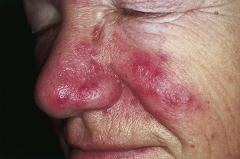
Severe Spider Veins with Rosacea
Photo by By M. Sand, D. Sand, C. Thrandorf, V. Paech, P. Altmeyer, F. G. Bechara
Pregnant women should always consult with their obstetricians regarding all nutritional supplements, but rutin is generally accepted as safe for use during pregnancy. Author Susun Weed suggests that it might be used to prevent implantation of the fertilized egg to avoid pregnancy, but rutin will not interfere with the unborn child's development once pregnancy has begun.
Rosacea also causes spider veins. Many people who use rutin products find that they help relieve both the rosacea and the spider veins.
Q. Can rutin supplements be used to treat schizophrenia?
A. There were two clinical trials in Australia the 1980's that found improvements on the Brief Psychiatric Rating Scale for a small number of schizophrenics who were given the commercial hydroxyethylrutoside supplements Paroven and Venoruton. Half of the patients given the supplements showed improvement in anxiety, depression, delusions, and unusual behavior. Dosing was according to the manufacturer's label.
Q. What about rutin for cats?
A. There is a single case report in the literature of veterinary medicine about using rutin to treat a condition called chylothorax in one cat. Chylothorax is an accumulation of a milky, protein-filled fluid in the space between the lungs and the muscles in the wall of the chest. It is usually treated with a low-fat diet along with frequent trips to the vet to have fluid drawn out of the chest cavity with a syringe.
In this study, giving the cat a single 500 mg capsule of rutin every day doubled lung volume in 20 days by shrinking the swelling around the lungs. Over the next 60 days, the cat's lung volume increased another 30%.
The veterinarian writing the study commented that cats apparently have no objection to the taste or odor of rutin, but cautioned that sometimes cats get over chylothorax spontaenously, and it was not possible to be absolutely sure the effect was due to rutin.
Q. Can rutin be used to treat bruising?
A. Yes, but my first choice would be diosmin with hesperidin. It's OK to use rutin or aescin (horse chestnut seed extract) in addition to diosmin with hesperidin. If the bruising is a reaction to treatment with prescription blood thinners, rutin may interfere with the action of the drug. Don't take rutin if you are also taking Coumadin, Plavix, Trental, or any other prescription blood thinning medication without a doctor's supervision.
Selected References:
Bast A, Haenen GR. The toxicity of antioxidants and their metabolites. Environmental Toxicology and Pharmacology. 2002;11:251-258.
Boots AW, Haenen GR, Bast A. Health effects of quercetin: from antioxidant to nutraceutical. Eur J Pharmacol. 2008;585:325-337.
Amic D, Davidovic-Amic D, Beslo D, Rastija V, Lucic B, et al. SAR and QSAR of the antioxidant activity of flavonoids. Curr Med Chem. 2007;14:827-845.
Boots AW, Kubben N, Haenen GR, Bast A. Oxidized quercetin reacts with thiols rather than with ascorbate: implication for quercetin supplementation. Biochem Biophys Res Commun. 2003;308:560-565.
Boots AW, Li H, Schins RP, Duffin R, Heemskerk JW, et al. The quercetin paradox. Toxicol Appl Pharmacol. 2007;222:89-96.
Bowry VW, Ingold KU, Stocker R. Vitamin E in human low-density lipoprotein. When and how this antioxidant becomes a pro-oxidant. Biochem J. 1992;288 (Pt 2):341-344.
Brubacher D, Moser U, Jordan P. Vitamin C concentrations in plasma as a function of intake: a meta-analysis. Int J Vitam Nutr Res. 2000;70:226-237.
Bruynzeel AM, Niessen HW, Bronzwaer JG, van der Hoeven JJ, Berkhof J, et al. The effect of monohydroxyethylrutoside on doxorubicin-induced cardiotoxicity in patients treated for metastatic cancer in a phase II study. Br J Cancer. 2007;97:1084-1089.
Formica JV, Regelson W. Review of the biology of Quercetin and related bioflavonoids. Food Chem Toxicol. 1995;33:1061-1080.
Haenen GR, Jansen FP, Bast A. The antioxidant properties of five O-(---Hydroxyethyl)-Rutosides of the flavonoid mixture Venoruton. Phlebology. 1993;(Suppl. 1):10-17.
Hertog MG, Hollman PC, Katan MB, Kromhout D. Intake of potentially anticarcinogenic flavonoids and their determinants in adults in The Netherlands. Nutr Cancer. 1993;20:21-29.
Jacobs H, van der Vijgh WJ, Koek GH, Draaisma GJ, Moalin M, et al. Characterization of the glutathione conjugate of the semisynthetic flavonoid monoHER. Free Radic Biol Med. 2009;46:1567-1573.
Kuhnau J. The flavonoids. A class of semi-essential food components: their role in human nutrition. World Rev Nutr Diet. 1976;24:117-191.
Landis-Piwowar KR, Dou QP. Polyphenols: biological activities, molecular targets, and the effect of methylation. Curr Mol Pharmacol. 2008;1:233-243.
Liu HL, Jiang WB, Xie MX. Flavonoids: recent advances as anticancer drugs. Recent Pat Anticancer Drug Discov. 2010;5:152-164.
Meister A. Glutathione-ascorbic acid antioxidant system in animals. J Biol Chem. 1994;269:9397-9400.
Meister A. Glutathione, ascorbate, and cellular protection. Cancer Res. 1994;54:1969s-1975s.
Mukai K, Nishimura M, Kikuchi S. Stopped-flow investigation of the reaction of vitamin C with tocopheroxyl radical in aqueous triton X-100 micellar solutions. The structure-activity relationship of the regeneration reaction of tocopherol by vitamin C. J Biol Chem. 1991;266:274-278.
Niki E. Interaction of ascorbate and alpha-tocopherol. Ann N Y Acad Sci. 1987;498:186-199.
Packer JE, Slater TF, Willson RL. Direct observation of a free radical interaction between vitamin E and vitamin C. Nature. 1979;278:737-738.
Petruzzellis V, Troccoli T, Candiani C, Guarisco R, Lospalluti M, et al. Oxerutins (Venoruton): efficacy in chronic venous insufficiency-a double-blind, randomized, controlled study. Angiology. 2002;53:257-263.
Rathee P, Chaudhary H, Rathee S, Rathee D, Kumar V, et al. Mechanism of action of flavonoids as anti-inflammatory agents: a review. Inflamm Allergy Drug Targets. 2009;8:229-235.
Upston JM, Terentis AC, Stocker R. Tocopherol-mediated peroxidation of lipoproteins: implications for vitamin E as a potential antiatherogenic supplement. Faseb J. 1999;13:977-994.
Van Acker FA, van Acker SA, Kramer K, Haenen GR, Bast A, et al. 7-monohydroxyethylrutoside protects against chronic doxorubicin-induced cardiotoxicity when administered only once per week. Clin Cancer Res. 2000;6:1337-1341.
Van Acker SA, Kramer K, Grimbergen JA, van den Berg DJ, van der Vijgh WJ, et al. Monohydroxyethylrutoside as protector against chronic doxorubicin-induced cardiotoxicity. Br J Pharmacol. 1995;115:1260-1264.
Willems AM, Bruynzeel AM, Kedde MA, van Groeningen CJ, Bast A, et al. A phase I study of monohydroxyethylrutoside in healthy volunteers. Cancer Chemother Pharmacol. 2006;57:678-684.
Yu BP. Cellular defenses against damage from reactive oxygen species. Physiol Rev. 1994;74:139-162.
-
Skin CareMen Skin Care
-
Free ResourcesFree eBooks
-
Whatever we put our attention on will grow stronger in our life.Maharishi Mahesh Yogi
-
What We RecommendIf you do an analysis of the ingredients in a bottle of
 Total Balance and compare with other products you will find that it provides exceptional value for money…even against simple mass produced products with lower bottle costs.
Total Balance and compare with other products you will find that it provides exceptional value for money…even against simple mass produced products with lower bottle costs.
-


